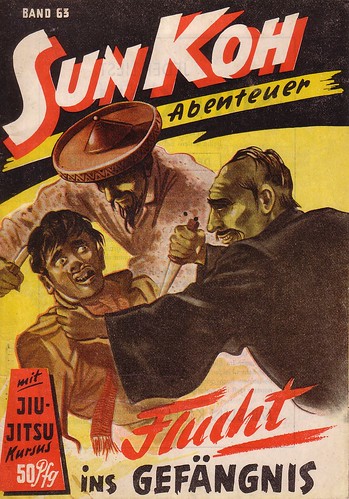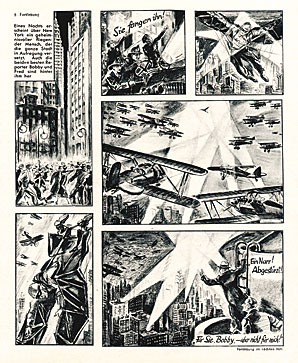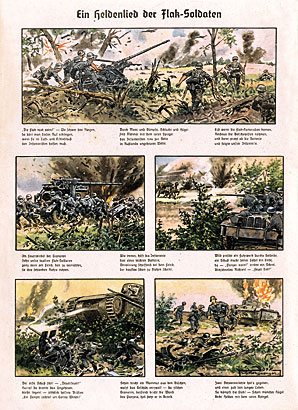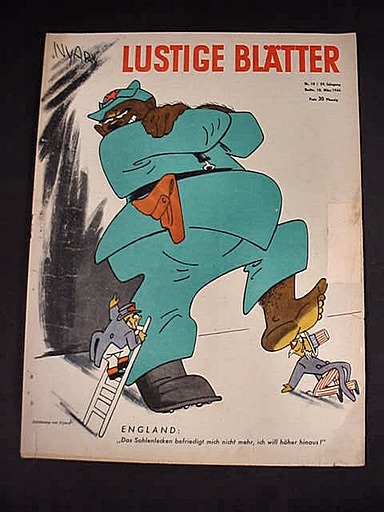Yes, I checked and a lot of images were gone from this article but I'm told that happens a lot! Seriously, one week and I'm fed up and The Other Guy did this seven days a week all year?
But as today was Herr Hooper-Scharf's pre-designated "Germany Day" (really) here goes item 1:
And The Myth Continues -"Germany Had NO Comics In World War 2!"
Yes, one of those snooty "intellectual" comic club people, who know everything about comics and what they do not know is of "no significance" has again claimed "there were absolutely no comics in Germany under the Nazis"

You have to remember that Germany had a thriving pulp magazines market with characters such as Dr Mabuse, Tom Shark, Captain Mohr's, Sun-Ko and more. Just like in the UK and the United States. Most people are ignorant of these so not surprising they have no idea about comics in the 1939-45 period. I can tell you.....
Yes, Germany HAD War Time (1939-45) Comics
It is very interesting. ”What is?” you ask. Well, let me tell you.
For years my German grand-father told me there were comic strips in Germany during the 1939-1945 war. Oh, but all those comic ‘experts’ (X=The Unknown and Spurt is a drip under pressure) who are into the Bandes Dessinee chuckled at my stupidity: “Don’t you know? The Germans hated comics -they were banned. Silly boy.”
One might wonder WHY the country that gave us Max and Moritz (oh, just google them) would ban what could be useful propaganda tools -the Americans and Brits used comics for “Hun” and “Nip” bashing…uh, almost 70 years later they still do but it’s more liberal “can’t cut the string” between comics and Nazis that outright, often racist, propoganda.
I was even sure that, while at Kleine Marpe school in Germany I had seen a German war comic from the 1940s -found in someones barn but quickly confiscated (Gaarrgh!). But then…
JF Ptak Science Books made a quick post on 7th November, 2011
The Bilderbogen vom Krieg–some examples of propaganda aimed at German children, efforts to convince them of the winning of the war, evidently a universal attempt….
Source: Deutschsprachige Comics und Romanhefte vor 1945 here.
Source: Deutschsprachige Comics und Romanhefte vor 1945 here.
“Famany der fliegende Mensch” (1937) according to Puj Claus:"Famany -The Flying Man probably only appeared in the 1937 run of"Gazebo"- the hero using all means to fight against the criminal underworld in the U.S..


ooh, now don’t those look to you like war comics…from the Second World War period to boot.
The site in question is run by the same person who runs the Dideldum childrens comic page. It’s interesting but shows the utter stupidity of German law -Hitler has to have his face obscured as does any swastika. These are HISTORICAL publications but cannot be shown for fear of the law (yet Nazi thugs get together to celebrate Hitler’s birthday!!).
I need to go over the site more but I believe the owner Herr Claus is the person who discovered these. He is invaluable to German comics history!
And I have two war time German comics -Kiebitz nrs 9 and 10.
Kiebitz nr. 9, Januar 1941 published by Wilhelm Greve Gmbh. Note the cut out and dress similar to features in rritish comics for children at the time.
Kiebitz nr 10, Februar, 1941; These books are in near pristine condition considering their ages and this may be due to their having been file copies -note the hole punches for filing.
I'm told that when publishing had to be curtailed that it was heart-breaking for the publisher who retired.
Yes, the Germans did exactly what the Allied Countries did both comic strip, cartoon and pin-up wise. There really was not that much difference –but Germany mainly forgot its War time comics.
Now, of course, our beloved comic ‘experts’ will start announcing their “new discovery” with no credit to anyone else.
One expects this.












I'm writing a biography of an American, Mr. Carroll Rheinstrom who represented DC Comics in Europe, Australia, Latin America etc from 1948 to 1982. I'm seeking information about his bringing DC Comics to Germany after the war. I welcome in any information about him and the process. The publisher he dealt with in the beginning was Emil Keirsbilck.
ReplyDeleteHoward Blue memrevs@gmail.com
Forest Hills, New York
I apologize. I was wrong about Keirsbilk who was a French publisher. The German publisher of DC Comics was Adolf Kabatek.
ReplyDeleteKabatek is a well known figure amongst German comic collectors -old time collectors. There is a German language entry on him: Adolf Kabatek began in 1951 the publishing house Best in Stuttgart an apprenticeship as a publisher and was then taken over by the young Ehapa-Verlag. Together with Erika Fuchs , he supervised the Mickey Mouse there , which initially appeared monthly. Above all, Kabatek oversaw the production and distribution of the magazine right up to the receipt of the invoice. Quickly the Mickey Mouse had established itself. Immediately followed by other Disney comic series such as the Mickyvision , the Donald Duck special issues and later the funny paperbacks .
ReplyDeleteWhen the Association for Youth Magazines, " Europress Junior" was founded in the mid-1960s , Germany was represented by Kabatek. The association set up a moral code, according to which comics should contain neither violence nor immoral scenes. At these association meetings Kabatek met Georges Dargaud , who offered him the German rights for Asterix . In 1968, the first German band appeared with the adventures of the Gauls. Publisher Kabatek managed to establish the previously unknown in Germany albums format. He was also involved in the translations. Kabatek was a close friend of Asterix creator René Goscinnyand Albert Uderzo . Later he also published the German issues of the Lucky Luke series by Goscinny and Morris .
In 1972 Kabatek became managing director of the Ehapa publishing house and since 1974 has worked exclusively as a publisher. From 1975, the group management in Copenhagen entrusted him to take a responsible role in planning for Scandinavia and Great Britain . About the Association of German magazine publishers in 1972 he was also elected as an associate in the Federal Examination Office for youth-endangering writings .
With the much acclaimed and internationally successful Disney comic series "Adventure from Uncle Dagoberts Treasure Chest" Kabatek 1983 managed to excel as a comic book author. Although he left the drawings to others, idea, scenes and storylines of the stories came from him.
After leaving the company in 1988, he continued to work as a freelancer for the Ehapa publishing house. In addition, he worked on the screenplay for the movie Asterix - Operation Hinkelstein ( Astérix et le coup du menhir , 1989). Kabatek died on June 25, 1997 shortly before his 66th birthday from a heart condition .
I'm guesssing that info was of no interest. This is why I no longer bother with these requests.
ReplyDeleteHello Terry,
DeleteA belated thank you for your helpful reply!!!
Howard Blue